Hemingray Lights the World
by Bob Stahr
Reprinted from "Crown Jewels of the Wire", May 1997, page 7
The Hemingray Glass Company was known the world over for quality, dependable
insulators. However, Hemingray made much more than just insulators. A list of
products from Williams' Cincinnati Directory and Business Advertiser of 1867
includes the following: "Fruit jars, lamps, lanterns, chimneys, brandies,
hock wines, demijohns, screw cap flasks, tumblers, and a great variety of table
ware. Also, philosophical apparatus, and round & oval shades for artificial
flowers and statuettes. Solar, sun, and comet burners on hand in large
quantities." This list was a curiosity to me. If Hemingray made so much,
why can't I find it?
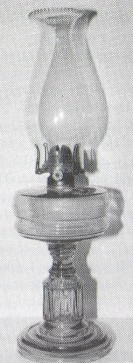
The search began with reading several Old Bottle Magazine
articles on Hemingray. Two names popped up a few times, Glenn Drummond and John
Webster. Glenn and John both collected Hemingray items in the mid to late 1970's. Their proximity to Covington sparked their interest in the early glass made
there. It was from Glenn that I heard my first rumor that the factory site of
Hemingray in Covington, KY was dug. Glenn had thought that some archaeologists
dug the factory and that the shards were taken to a museum or college. Glenn
suggested that I look up John. I did, and gave him a call. John confirmed that
the site was dug, and stated that "the shards were taken to the museum in
Devou Park" (in Covington).
With that information, I called Roger
Lucas, with whom I had been in contact ever since Roger and Darrin Cochran
displayed Hemingray dump items at the London, OH show. Roger and I had made a
previous trip to Covington to look at the Hemingrays' cemetery plot and to look
around the town for Hemingray items in antique shops. After telling Roger about
the dig and the museum, we decided it was worth the effort to make another trip
there. This time we looked up the cemetery plot of the Grays' and drove up into
Devou Park. After driving around we located a large mansion within the park. In front of the mansion was a locked gate at the entrance to a parking lot. The
sign at the gate read "Behringer-Crawford Museum." I wrote down the
name and we left to go about the rest of our business.
Back home and later in
the week, I called information for the phone number of the museum. I called and
talked to the receptionist who confirmed that they did own some Hemingray glass.
She referred me to one of the archaeologists who was involved with the dig.
After talking with the archeologist, I learned that the Hemingray factory site
was dug because Covington was redeveloping the riverfront where the factory once
stood. Federal money was involved in the re-development which meant an
archeological survey had to be done. The preliminary survey consisted of digging
a small hole with a backhoe. To our luck, one of the first things found in the
test hole was a complete bottle mold! With the items that were found in the test
hole, it was determined that the entire factory should be excavated. The entire
factory was excavated in 1986 and all the shards that were determined to be
important were catalogued, boxed up, and given to the museum. A three volume
report was written and a display was set up for a short time.
The archaeologist
was quite receptive to my questions. I asked how many shards of glass they had
and the archeologist responded with "approximately 200,000." This was
very exciting to hear and resulted in my asking to view some of the items. An
appointment was set up, and Roger Lucas joined me in my trip there again. Prior
to leaving, I told Rick Soller about it as well. Rick was going to Ohio that
week and would drop down to join us that day.
The archaeologist pulled about six
boxes from the display material for us to look at. There was a wide variety of
items including bottles, fruit jars, insulators, tableware and kerosene lamp
parts. I already had an idea of what bottles and fruit jars they made, but the
tableware and lamp parts were a total surprise. After we all took several
pictures of the shards, we left for home.
It was no secret to me that Hemingray
made lamps. I have numerous advertisements and references to lamp manufacture
covering four decades and I know Hemingray had rights to at least four patents
relating to lamp manufacture. The patents are:
March 30, 1869
D 3,436
Design for
a lamp chimney
February 23, 1875 160,016
Paper perforating machine (for paper lamp shades,
etc.)
May 14, 1878
D 10,678
Design for a glass lamp shade shaped like a human head
March 4, 1879
212,850
Machine for flaring and crimping lamp chimneys
Hemingray also held patent rights to their famous Elgin Oil can which held
the kerosene for filling these lamps. Proving that Hemingray made lamps was
easy, all I needed was proof of what patterns they made.
Upon arriving home from
the trip to the museum, one of the first things I did was go to the library.
Once there I found two excellent books by Catherine Thuro. The books, Oil
Lamps--The Kerosene Era in North America and Oil Lamps II, gave nomenclature,
history and plenty of pictures that helped me identify the pieces of the lamps
that were dug at Covington.
At this point it is necessary to identify styles and
different parts of lamps. The fount is the bowl-shaped reservoir the oil was
kept in, the burner is the metal portion that holds the wick, and the chimney is
the shade that sits on the burner to protect the flame. Stand lamps have the
fount on a pedestal-type base, finger lamps have small handles so they can be
held onto with a finger and carried across a room, and side lamps consist of a
tin wall hanger with a glass fount that sits inside of it.
A thumbprint design
in the fount of a lamp means that the fount has a pattern of "spots"
of thicker glass in a systematic pattern. Because of the thicker glass, these
spots appear in a darker color, thus the name thumbprint was given.
Hemingray
stand lamps were made in a three step process. The stand or base portion of a
lamp is pressed in a mold, the fount is blown in another mold, and the two are
brought together while still hot and "welded" together. This
construction makes it possible to mix and match different founts and different
bases. This can easily be seen in several of the stand lamps shown in this
article.
One unique feature of Hemingray made lamps is the way that the bases on
many of them are molded. Of the 11 lamps that I own, only one finger lamp and
one stand lamp lack what I call a "drip catcher base." When filling
the oil lamps, oil usually spills on the fount and migrates down the side of the
lamp to the base. The "drip catcher base" keeps these drops of oil
from staining tablecloths. The "drip catcher base" is not unique to
Hemingray, but the way it is made appears to be. Founts can also be made with
drip catchers, and these are rather specifically made as well.
As you probably noticed, on the front cover are pictures of the Stanbury and
the Vera lamps next to insulators of matching colors. I believe this helps
explain the variety of colors in insulators that we see from this time period.
Based on the styles and molding techniques of the lamps, they would have been
made in the 1880's to the turn of the century. Because of the lack of drip
points on the insulators of matching color, we know the insulators were made
prior to 1893 and most likely in the late 1880's since Hemingray's Muncie,
Indiana plant became operational around 1889 and the Covington plant supposedly
closed around 1892. It is quite possible that these insulators may have been
made out of a batch of excess glass that was used in lamp production.
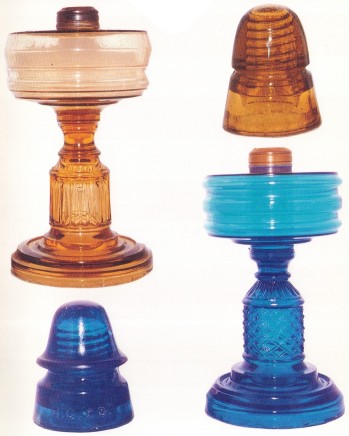
Medium Image (68 Kb)
Large Image (222 Kb)
The following pictures are of shards dug at the Covington factory and lamps from my
collection. In addition to shards dug at Covington, shards were also dug at the
Muncie, Indiana factory by Roger Lucas and Darrin Cochran. For photographing
purposes, some of the burners and chimneys have been removed.
Lamps I suspect
were made by Hemingray but are unconfirmed are Sheffield Swirl, Artichoke and
Shane patterns. Lamps confirmed to be made by Hemingray and the location they
were found follow. (Please refer to books by Thuro for lamps not pictured in
this article.)
|
Daisy & Button finger lamp
|
Covington, KY
|
|
Vera
|
Covington, KY
|
|
Stanbury
|
Covington, KY
|
|
Cooper
|
Covington, KY
|
|
Inverted Thumbprint and Prism Stem
|
Covington, KY/ Muncie, IN
|
|
Pearl Loop
|
Muncie, IN
|
|
Corner Windows
|
Muncie, IN
|
|
Simple Solid
Stem *
|
Muncie, IN
|
|
Simple Hollow Stem*
|
Muncie, IN
|
|
* Lamps not pictured in Thuro.
Names were given to eliminate confusion.
|
Shown on the following page is a beautiful Hemingray advertisement from the
trade journal China, Glass, and Lamps from December 2, 1891. The patent (Aug 12,
1879) on the Meteor lamp was not assigned to Hemingray although I suspect they
obtained rights to the manufacture of it. Courtesy of Dick Roller.
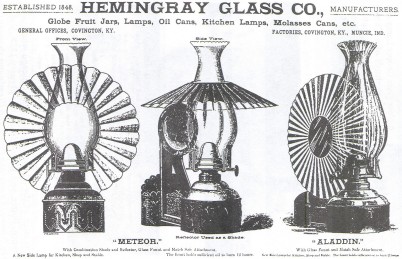
Medium Image (128 Kb)
Large Image (332 Kb)
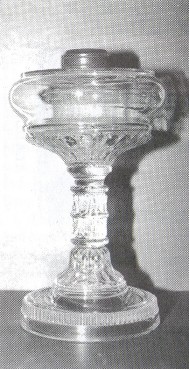 |
A clear glass Cooper Lamp and clear glass shards of a Cooper Lamp dug at the
Covington, Kentucky factory of the Hemingray Glass Company.
|
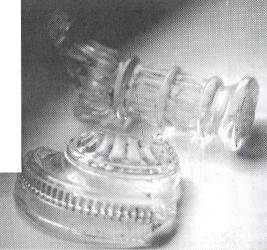 |

A portion of the advertisement of the Chicago wholesaler French, Potter,
and
Wilson from the February 1888, Vol. 7 No.2 issue of American Potter
and
Illuminator showing the Cooper lamp. Courtesy of Catherine Thuro.
 |
Two amber and one clear applied handle shards dug at the Covington, Kentucky
factory of Hemingray Glass Company. |
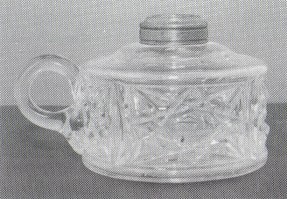
Clear glass Daisy and Button pattern finger lamp.
Note the applied handle.
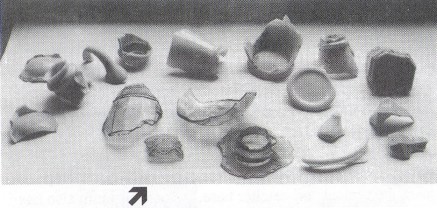
Peacock blue glass shard of Daisy and Button pattern finger lamp dug
at the
Covington, Kentucky factory of the Hemingray Glass Company surrounded
by
a shard of an amber Globe Tobacco jar and several syrup pitcher shards
in
various colors of milkglass.
|
Clear glass side lamp with oil filler. Note the similarity to the side lamps
advertised by Hemingray. This lamp also exists without the oil filter. |
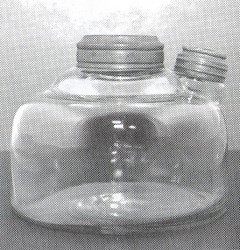 |
On following page:
(Top Left) Clear glass lamp with Cooper fount and Teardrop base. *
(Top Right) A Simple Solid Stem clear glass lamp with the typical "oil
catcher base." *
(Lower Left) A Simple Solid Stem clear glass lamp with the typical "oil
catcher base." Note this lamp also has a "drip catcher fount"
like Inverted Thumbprint and Prism Stem lamp (see page 13). Courtesy of Roger
Lucas. *
(Lower Right) A Simple Hollow Stem clear glass lamp with the typical
"oil catcher base." Note this lamp also has a "drip catcher
fount."
* Lamps not pictured in books by Thuro. Names were given to eliminate
confusion.
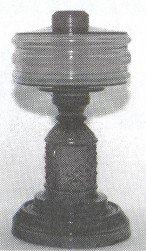 |
 |
|
Peacock blue glass "Vera" lamp. This lamp also exists in amber
glass. |
Amber glass Stanbury Lamp and a light green glass shard of Stanbury Lamp
(pictured below) dug at the Covington, Kentucky factory of the Hemingray Glass
Company. |
|

|
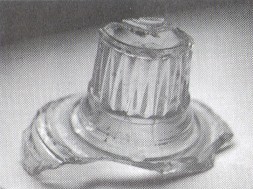 |
|
Amber Stanbury lamp complete with burner and chimney. |
|

|
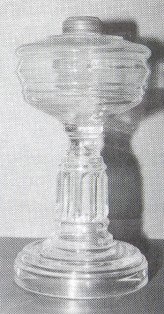
|
|
A variation of the Inverted Thumbprint and Prism Stem lamp in
clearglass.
This lamp lacks the Thumbprint pattern in the fount. |
Clear glass lamp with Prism stem and Prism fount and the typical "oil
catcher base." * |
|
|
|
Peacock blue shards of the Inverted Thumbprint and Prism Stem lamp dug at the
Covington, Kentucky factory of the Hemingray Glass Company. |
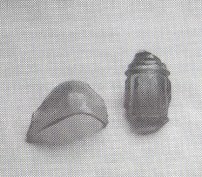
|
* Lamp not pictured in books by Thuro. Names given to eliminate confusion. |
| 